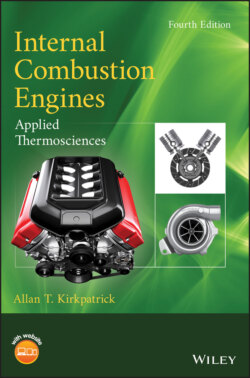Читать книгу Internal Combustion Engines - Allan T. Kirkpatrick - Страница 19
Engine Work, Power, Torque, and Mechanical Efficiency
ОглавлениеThe indicated work of an engine is the net work done by the gas during a compression and expansion cycle. It is equal to the integral of the pressure over the cylinder volume:
(1.8)
The engine power is the rate at which work is done by the engine, and for an engine with cylinders is
since the four‐stroke engine has two revolutions per power stroke and the two‐stroke engine has one revolution per power stroke.
The brake power is the power output of the engine measured by a dynamometer. Early dynamometers were simple brake mechanisms, hence the use of the term . The engine torque, , is a measure of the work done per unit rotation (radians) of the crank. As we shall see when discussing dynamometers in Chapter 12, the brake power and torque for both two‐ and four‐stroke engines are related by
(1.11)
The net brake power is from the complete engine; whereas gross brake power is from an engine without the cooling fan, muffler, and tail pipe. The brake power is less than the indicated power due to engine mechanical friction, pumping losses in the intake and exhaust, and accessory power needs, which are grouped as a friction power loss, :
(1.12)
The ratio of the brake power to the indicated power is the mechanical efficiency, :
(1.13)
The wide open throttle performance of a 2.0 L automotive four‐stroke engine is plotted in Figure 1.7. As with most engines, the torque and power both exhibit maxima with engine speed. Viscous friction effects increase quadratically with engine speed, causing the torque curve to decrease at high engine speeds. The maximum torque occurs at lower speed than maximum power, since power is the product of torque and speed. Notice that the torque curve is rippled. This is due to both inlet and exhaust airflow dynamics and mechanical friction, discussed later.
Figure 1.7 Wide‐open throttle (WOT) performance of an automotive four‐stroke engine.
